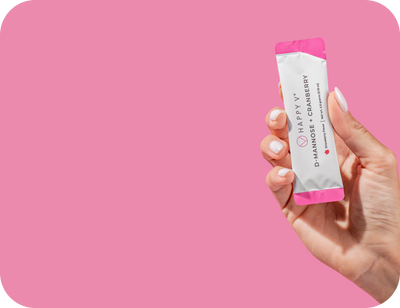- Fact Checked
- October 10, 2025
- 12 min read
Why Do I Keep Getting UTIs? Understanding the Causes & How to Break the Cycle
Table of Contents
Table of Contents
If it feels like you’re constantly battling urinary tract infections (UTIs), you’re not alone. They’re one of the most common infections in women, and for some, they become a stubborn, recurring issue1. Though these infections are often highly treatable with antibiotics, recurrent UTIs can chip away at your quality of life, affect your relationships, and shake your confidence in your own body.
No matter how long you’ve been stuck in the UTI cycle, there’s a way forward. It all starts with understanding what causes them, why they keep coming back, and how to protect your body using both antibiotics and smart, science-backed prevention strategies.
This post is for informational purposes only and does not constitute medical advice. See full disclaimer below.
What Are Recurrent UTIs?
Recurrent urinary tract infections (UTIs) are a major health issue—especially for women—and they’re more than just a temporary nuisance. Recurrent UTIs (rUTIs) are defined as:
- Two infections in 6 months or
- Three or more infections in one year2
UTIs are typically diagnosed using:
- Urine culture and urinalysis to identify the specific bacteria causing infection
- Imaging tests like an ultrasound or CT scan to check for kidney stones or structural issues
- Cystoscopy, a test that allows your doctor to view the inside of your bladder
- Referral to a urologist for specialized evaluation and long-term care
Symptoms of Recurrent UTIs
The symptoms of UTIs mirror those of regular, one-off infections and can include:
- Burning sensation when urinating
- Frequent urge to pee, even after just going
- Cloudy or foul-smelling urine
- Lower abdominal or back pain
- Mild fever (in some cases)
Persistent or severe cases could lead to kidney infections or cystitis3, so always consult your healthcare provider at the first sign of UTI symptoms.
How UTIs Are Treated
When a urinary tract infection strikes, treatment typically starts with a short course of antibiotics4 (usually three to seven days, depending on the severity).
These medications are designed to quickly kill the bacteria causing the infection, most commonly E. coli5. Many people feel symptom relief within a day or two, but it’s important to finish the full course to prevent the infection from coming back stronger.
For those with recurrent or complicated UTIs, though, treatment may go a step further. A healthcare provider might recommend:
- Longer-term or rotating antibiotics
- Low-dose prophylactic antibiotics, taken daily or after sex
- Vaginal estrogen therapy for postmenopausal women to restore protective flora
- Additional testing (like urine cultures, ultrasounds, or cystoscopy) to rule out structural problems or kidney involvement
The Stats: How Common Are Recurrent UTIs?
Recurrent UTIs can take a huge mental and emotional toll. If you are feeling trapped and alone in a cycle of infection and discomfort, you are far from alone.
- 40% to 60% of women in the U.S. will experience a UTI at least once in their lives6.
- About 10% of adult women get one annually7.
- 35% to 53% of women treated for a UTI will get another one within a year.
- If long-term antibiotics are stopped, up to 60% experience recurrence within just 3 months.
- Women are 50x more likely than men to get UTIs.
- The economic toll? UTIs cost the U.S. over $1.6 billion annually in management expenses8.
Why Do I Keep Getting UTIs?
One of the reasons that UTIs are so common is that there are a lot of risk factors at play, some of which can be avoided and some of which can’t.
1. Bacterial Invaders (mostly E. coli)
The most common culprit behind urinary tract infections is Escherichia coli (E. coli)9, responsible for up to 80% of cases. These bacteria are equipped with tools that help them survive and thrive in your urinary tract:
- Fimbrial adhesins (like P-fimbriae and FimH) that let them stick to the urethral lining
- Biofilm formation that shields them from antibiotics and immune defenses10
- Intracellular reservoirs, where they hide inside bladder cells and re-emerge later
Other bacteria, such as Klebsiella pneumoniae, Proteus mirabilis, and Staphylococcus saprophyticus, can also contribute, but E. coli remains the leading cause11.
2. Hygiene and Bathroom Habits
When it comes to UTIs, hygiene often gets blamed first. But the truth is, it’s not about being “clean enough”; it’s about how you handle basic bathroom habits12.
Certain practices can unintentionally increase your risk of introducing bacteria into the urinary tract, especially given how close the female urethra is to both the vagina and anus.
Bathroom habits that can contribute to UTIs include:
- Wiping back to front can transfer bacteria like E. coli from the anus to the urethra13
- Holding in urine gives bacteria more time to grow and colonize the bladder14
- Not drying properly after using the restroom can leave behind moisture that fosters bacterial growth
- Using harsh cleansers or wipes can disrupt the natural balance of protective bacteria around the vaginal and urethral openings
But Hygiene Isn’t the Whole Story
It’s a common misconception that recurrent UTIs are just a sign of poor hygiene. In reality, many people who follow all the right bathroom habits still struggle with chronic infections.
Factors like anatomy, hormones, genetics, or immune health (which we’ll get into next) often play a much bigger role. Blaming yourself (or assuming you’re doing something wrong) can add unnecessary shame to an already painful experience.
While poor bathroom habits can increase your risk, they’re only one part of a much more complex picture. The goal isn’t perfection. It’s about giving your body the best chance to defend itself with a few supportive, sustainable practices.
Bathroom Habits for Everyone
Although women are most at risk, men and children can also develop UTIs, especially if hygiene is difficult due to mobility or cognitive challenges. Teaching good bathroom habits, like wiping front to back and not holding urine, is important for all ages and genders.
3. Sexual Activity
Let’s be clear: UTIs are not contagious—you can’t catch one from a partner like you would a cold or a sexually transmitted infection (STI)15. However, sexual activity is a major risk factor for UTIs because it can introduce bacteria into the urinary tract16.
And we aren’t just talking about penetrative sex, either! Bacteria can enter the urethra from:
- Your partner’s genitals, fingers, mouth, or sex toys
- Your own genital or anal area during penetration or friction
- Certain lubricants or bodily fluids that alter pH or flora
Birth control methods also play a role:
- Spermicides and diaphragms can disrupt the natural vaginal flora—especially Lactobacillus—making it easier for E. coli to multiply17.
4. Anatomical and Hormonal Risk Factors
Several biological and life-stage factors can make women more susceptible to UTIs:
- Shorter urethra and proximity to the anus allow bacteria quicker access18
- Menopause and reduced estrogen levels weaken the urethral lining and alter vaginal pH
- Postmenopausal women often have lower levels of protective Lactobacillus, increasing bacterial imbalance
- Kidney stones, catheters, and urinary tract abnormalities can obstruct urine flow or introduce pathogens
- Immune suppression, poor hygiene, or recent urinary procedures can also make UTIs more likely
5. Treatment Challenges
Even if you’re taking antibiotics, they may not be enough to stop the cycle—especially if the bacteria are playing the long game.
- Overuse of antibiotics leads to resistance, making infections harder to treat
- Rebound infections can occur soon after a course of antibiotics ends
- Bacteria may appear “cleared” but remain dormant in the urethra or bladder lining, leading to recurrence weeks or months later
Breaking the Cycle: Natural Strategies That Work
Make no mistake: when a UTI strikes, antibiotics are often necessary to clear the active infection19. But when it comes to keeping UTIs from coming back, prevention is where the real work begins. Supporting your body with daily habits and targeted strategies can help break the cycle and reduce your risk of recurrence.
Here are research-backed, practical ways to give your urinary tract the ongoing support it needs:
1. Practice Smart Hygiene
The most effective strategies include:
- Wipe front to back after using the bathroom to avoid introducing bacteria from the rectum to the urethra
- Urinate after sex to flush bacteria from the urethra
- Avoid douches, sprays, or scented soaps around the vulva—they can disrupt your vaginal pH and microbiome
- Choose cotton underwear and change it daily to keep the genital area dry and breathable
- Take showers instead of baths, especially if you’re prone to infections
2. Incorporate Healthy Sexual Hygiene Habits
Sex can be a trigger for UTIs, but that doesn’t mean you have to give up sex entirely! Small shifts in routine can reduce your risk without ruining the moment.
- Clean genitals and hands before and after sex (for both partners)
- Avoid going from anal to vaginal contact without washing or using protection
- Use non-spermicidal condoms or water-based lubricants to avoid disrupting vaginal flora
- Wash sex toys thoroughly before and after use, and avoid sharing
- Communicate with your partner about hygiene and STI screening if UTIs are recurring
These habits all help reduce the number of bacteria introduced into the urethral area.
3. Stay Hydrated
Drink plenty of fluids, especially water, to dilute urine and help flush out bacteria before they take hold. Aim for 8-10 glasses of water a day.
4. Add Targeted Supplements to Your Routine
If you're looking for daily, antibiotic-free UTI support, two ingredients stand out: cranberry extract and D-mannose20.
Choose Cranberry Supplements—Not Juice
Skip the sugary juice and go for a clinically studied supplement. Pacran®, a whole-fruit cranberry powder, has been shown to reduce UTI recurrence by 58% over six months and lower E. coli-related infections from 24% to 8%. Its A-type proanthocyanidins (PACs) help prevent bacteria from sticking to the urinary tract lining.
Add D-Mannose
This simple, naturally occuring sugar binds to E. coli, helping flush it out before it causes infection. In a study of 308 women with recurrent UTIs, only 14.6% of those taking D-mannose had a recurrence—compared to 60.8% in the no-treatment group. It performed nearly as well as antibiotics but with fewer side effects.
Or Get Both in One Capsule
Happy V’s D-Mannose & Cranberry Capsules combine 250 mg of D-mannose and 250 mg of Pacran® in one daily supplement. It's a science-backed way to protect your urinary tract—naturally.
FAQs About Recurrent UTIs
Why do my UTIs keep coming back?
UTIs may return due to persistent bacterial reservoirs, anatomical issues, or changes in vaginal flora (especially after menopause, sex, or antibiotic use).
Can poor hygiene cause UTIs?
Yes—especially if wiping back to front, using irritating products, or not urinating frequently enough.
Are recurrent UTIs contagious?
UTIs aren’t considered sexually transmitted infections, but sexual partners can play a role in bacterial transfer.
Can a UTI go away on its own?
Mild cases might, but recurrence or progression to a kidney infection is a risk. A urine culture and evaluation by a urologist or healthcare provider are recommended.
What tests diagnose chronic UTIs?
Urine sample, Urinalysis, and Urine cultures all help diagnose a UTI. In some cases (like chronic ones), your doctor may request a cystoscopy, imaging, or post-void residual tests.
Complications and When to Seek Help
Recurrent UTIs aren’t just uncomfortable. They can actually lead to serious health risks if left untreated or mismanaged.
While many infections clear up with proper care, frequent or unresolved UTIs can escalate into conditions that affect not just your urinary tract, but your entire body and quality of life.
Potential Complications of Recurrent UTIs
Recurrent UTIs may increase your risk of developing:
- Kidney infections (pyelonephritis): Untreated bladder infections can reach the kidneys, causing permanent damage or kidney disease.
- Sepsis (bloodstream infection): A UTI that spreads to the bloodstream becomes a life-threatening emergency, especially in older adults.
- Chronic bladder pain and inflammation: Persistent inflammation may lead to interstitial cystitis or ongoing pelvic pain.
- Antibiotic resistance: Repeated antibiotic use can make infections harder to treat over time.
- Pregnancy complications: If you're pregnant, recurrent UTIs can increase the risk of preterm birth and low birth weight.
These risks highlight why it's critical to take UTIs seriously, even when symptoms seem mild.
When to Seek Immediate Medical Help
You should see your healthcare provider for any UTI that:
- Happens more than twice in six months or three or more times in a year
- Doesn’t improve after a full course of antibiotics
- Returns quickly after treatment
But in some cases, a UTI can turn into a medical emergency. Head to the emergency room or urgent care if you experience:
- High fever (over 101°F/38.3°C)
- Chills or shaking
- Nausea or vomiting
- Severe back or side pain (flank pain near the kidneys)
- Confusion, disorientation, or difficulty breathing
The Hidden Toll: Mental Health & Quality of Life
Chronic or complicated UTIs don’t just affect your bladder. They affect your life. Many people with recurrent UTIs report:
- Anxiety around sex or travel
- Frequent absences from work
- Sleep disturbances and discomfort
- Mental exhaustion from always being “on alert” for symptoms
You're not being dramatic. This cycle is draining, disruptive, and isolating. If you feel like your UTIs are affecting your mental health, reach out to a therapist or other mental health professional, along with your doctor.
Final Thoughts
Recurrent UTIs aren’t just frustrating—they can interfere with work, relationships, and mental health. But understanding your triggers, changing your habits, and using science-backed tools can help break the cycle.
Keep the Conversation Going
-
Visit our blog for more women’s health tips.
-
Join our private Happy V Facebook group to hear from others who’ve been there.
- Explore supplements designed to support your vaginal health journey
Disclaimer: This blog is for informational and educational purposes only and is not intended to diagnose, treat, cure, or prevent any disease. Statements about supplements have not been evaluated by the Food and Drug Administration. For more information about vaginal infections, visit the CDC or speak to a licensed healthcare provider.












